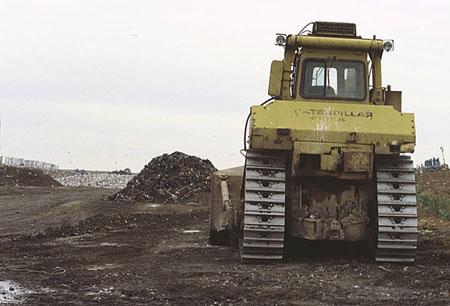When fieldwork is fieldwork
Reclaiming ‘degraded’ land is focus of Gund Hall exhibit

Niall Kirkwood’s Scottish accent may be tricky to detect and trickier still to identify, but despite the years he has spent in this country – years that have softened his native burr – his attitude toward land use still retains the influence of his national origins.
“When you come from a country like Scotland where there is little usable land area, you just naturally think more in terms of recycling. Europe is generally more used to recycling because it ran out of land earlier.”
It wasn’t just Scotland’s environmental issues but those of the British Isles as well that influenced Kirkwood’s early professional training. He first studied design in Manchester, England (“It was the first industrial city and the first industrial city to go into decline.”), then returned to Scotland for his first job.
The site was Saltcoats, Ayrshire, an old mining operation that had been used as a municipal landfill. Kirkwood helped turn it into a public park and golf course.
“It was my first introduction to the idea that a derelict site could be returned to the public good,” Kirkwood said.
Since then, Kirkwood has made reclaiming degraded environments a major focus of his teaching and research. A member of the Graduate School of Design (GSD) faculty since 1993, he was promoted to professor of Landscape Architecture and Technology this past July. He is also the founder and director of the Center for Technology and Environment and director of the Master in Landscape Architecture Programs.
Kirkwood is also co-curator with Robert France, associate professor of Landscape Ecology, of a new exhibition in Gund Hall: “Reclaimed! Brown Fields & Gray Waters: Case Studies of Reclamation Processes and Design Practices.” The exhibition runs from Oct. 25 to Nov. 25 and is coordinated with an international conference on the same topic, taking place Nov. 9-11.
The exhibition focuses on five degraded or contaminated sites in Holland, England, Mexico, and the United States, and what is being done or might be done to reclaim them. One of these sites, Fresh Kills landfill on Staten Island, N.Y., has taken on new significance as a result of the events of Sept. 11.
Opened in 1948, the 2,200-acre site was for more than 50 years the major repository for New York City’s garbage. At peak volume during the 1980s, Fresh Kills (the name is Dutch for fresh stream or channel) was absorbing 27 million tons of refuse per day, making it the largest landfill in the world.
Because it is so extensive and includes natural wetlands as well as disturbed landfill areas, Fresh Kills is in many ways a beautiful site, a refuge for many forms of wildlife, including raptors that prey on the abundant rats.
“When you’re on the site it’s actually very moving,” Kirkwood said. “You can see the skyline of Manhattan and the strip malls and housing projects of Staten Island, but at the same time it’s a place of extreme beauty and quiet.”
For most residents of Staten Island, however, the smells and other negative side effects of having an enormous landfill in the neighborhood far outweighed the site’s aesthetic appeal. Fresh Kills was finally shut down in March 2001, and arrangements were made to ship the city’s refuse elsewhere. On Sept. 13, however, an announcement was made that Fresh Kills would be reopened to accept the 1.2 million tons of debris from the destruction of the World Trade Center.
An international design competition was announced in the spring of 2001 to choose a plan for the reclamation of Fresh Kills, but the deposit of the World Trade Center debris imposes new requirements for such a plan.
“The question is, to what extent is the site concerned with its past history as a landfill and its reuse as a new public resource, and to what extent is it about this latest event? How will the proposals address the memorial aspects of the World Trade Center debris?” Kirkwood asked.
Each of the sites featured in the exhibition raises a host of similar questions, involving not simply the technical aspects of reclaiming degraded lands but issues of public health, urban development, economics, and environmental justice. These sites include Westergasfabriek, an abandoned gas factory in Amsterdam, Holland; Las Vegas Wash, a disturbed wetland near Las Vegas; Barn Elms Reservoirs and Waterworks on the outskirts of London; and Xochimilco, an extensive wetland south of Mexico City characterized by canals and floating islands.
Cleaning up these sites involves so many interrelated issues, Kirkwood believes, that dealing with brown fields easily fits the requirements for former President Neil Rudenstine’s Interfaculty Inititatives – problems sufficiently complex that they require scholars to work collaboratively across disciplines and institutional boundaries.
“No single person has a view of the whole thing. It’s one of the most synthetic areas of research,” Kirkwood said.
Kirkwood predicts that the reclamation of so-called brown field sites will constitute a new focus both for the GSD and for communities and municipalities around the world as populations confront the legacy of industrialization. By a conservative estimate, there are between 450,000 and 600,000 brown field sites in the United States, some of them of enormous size. Decommissioned military bases, for example, can be 20,000 acres and more. And in many areas of Europe, Asia, and Latin America, brown field sites are even more prevalent. Each of these sites presents its own problems and its own opportunities.
“This issue is going to be with us for a very long time,” said Kirkwood. “Perhaps in the future we can learn to anticipate and address degradation through sustainable practices rather than simply responding to it.”




